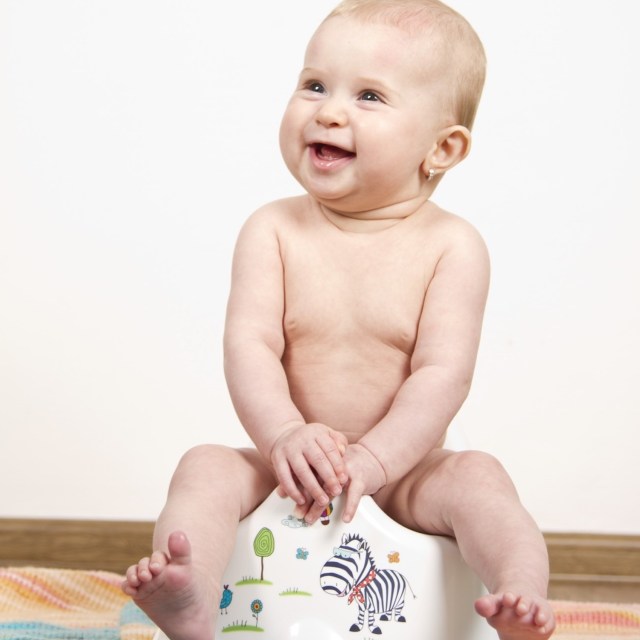Potty training is a huge milestone in every young child’s life and this is especially true for parents. A potty-trained child means no more diapers, changing tables, or accidents. But every child develops at a different rate, which means there’s no guarantees as to what age your child will be fully potty-trained.
Both girls and boys possess the physical maturity and readiness to potty train starting at age 18-30 months but that doesn’t mean your child will master potty training in this time frame. One of the most important things to keep in mind when starting the potty training process is that every child is different.
Here are some additional tips that worked for me, not only when it came time to potty train my son, but also during my time working in childcare.
1. Be Consistent
Consistency is key whenever it’s time to implement a new routine or schedule with your child. Children thrive on routine. It helps them to feel secure and safe in their environments. This means if you decide to have your child try to use the bathroom every 30 minutes, you need to keep this routine throughout the day – even on the weekends. If your child knows that after breakfast, before and after a nap, and before their afternoon snack that it’s time to sit on the potty, this will help their bodies develop a pattern.
Consistency also helps avoid confusion. That means don’t start a potty training plan and then switch back to old habits of using diapers. Once you make the switch from diapers or pull-ups to underwear, it’s important to stick with it—even in the face of accidents. The hard work will pay off!
2. Use Positive Reinforcement
Positive reinforcement is a huge part of potty training success. Whether this comes in the form of a sweet treat, small toy, sticker chart or additional five minutes of your child’s favorite show, positive reinforcement helps motivate and inspire your child to achieve.
If your child does have an accident, react in a positive and encouraging manner. You can say things like, “It’s okay, we’ll do better next time.” Or remind them to ask or go to the bathroom themselves if they feel the urge to go. Never make your child feel bad or less-than when it comes to accidents. The last thing you want to do is create a negative feeling about the process. Once your child views potty training as a scary or “bad” thing, this can be very difficult to bounce back from.
3. Follow Your Child’s Lead
As I said before, potty training happens at different times for every child. Sure, they might be physically mature by age 18 months but some children might lack interest in using the potty until much later. A young child will often show signs when they’re ready to start training. They might ask questions when you go to the bathroom or even ask to join you. If they begin showing interest, it might be time to purchase a small potty chair or seat for your toilet. You can also have your child pick out their own big boy or big girl underwear. This will give them a sense of independence and involvement in the process.
4. Talk About It
Familiarizing your child with potty training can make the transition much easier. There are countless books available that talk about potty training in fun and informative ways. Get your child excited about the process.
You can even make potty training a game. For small boys, you can place Cheerios in the toilet and have them practice their aim while urinating. Whatever gets them interested in peeing on the toilet instead of in a diaper or underwear is a true mom-win!
5. Be Patient
Like anything in life, achieving potty training success will be worth the wait. That means you’ll need to remain calm and patient throughout the process. Try not to get discouraged or frustrated if things don’t go as quickly as you expected. Your child will sense your tension and can even mistake your impatience with disapproval.
It’s also common for children to master peeing on the potty before they’re willing to go Number 2. This is extremely normal and should be expected. Trust the process and trust in the fact that your child will hit their marks when their body is ready.
6. Lose the Clothes
There is something to be said for allowing your child to safely run around naked in the privacy of your home. This makes it much easier for them to respond to their urge to go, without struggling with underwear or pants. When a child is just learning how to recognize and respond to these feelings, the faster they can get to the potty, the better!
I am fortunate enough to have a pretty secluded backyard. When my son was 2 and a half and it was summertime, we set up a small inflatable pool on our relatively private deck. I also brought out his Lightning McQueen potty seat. He ran around naked, going in and out of the pool until he felt the urge to pee. He ran over to his potty seat and did his business. Just a few minutes later, he said he needed to go Number 2 and he did! Allowing him to stay naked really helped him become aware of his body and react to his natural urges.
Don’t Stress… It WILL Happen!
Don’t stress if your child is not interested in using the potty. Don’t stress if your first child potty-trained sooner or easier than your second. And don’t stress is your friend’s children are potty-training before yours. Each child is unique and special in their own way.











